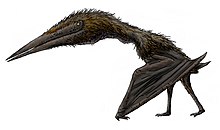Aerotitan
| Aerotitan Temporal range: Maastrichtian
~ | |
|---|---|

| |
| Restoration of Aerotitan as an azhdarchid, following the original interpretation | |
| Scientific classification | |
| Domain: | Eukaryota |
| Kingdom: | Animalia |
| Phylum: | Chordata |
| Order: | †Pterosauria |
| Suborder: | †Pterodactyloidea |
| Family: | †Azhdarchidae |
| Genus: | †Aerotitan Novas et al. 2012 |
| Species: | †A. sudamericanus
|
| Binomial name | |
| †Aerotitan sudamericanus Novas et al. 2012
| |
Aerotitan is a genus of large azhdarchid pterosaur known from the Late Cretaceous Allen Formation of the Neuquén Basin in northern Patagonia, Argentina.[1]
Discovery and naming
The type species Aerotitan sudamericanus was named and described in 2012 by Fernando Novas, Martin Kundrat, Federico Agnolín, Martin Ezcurra, Per Erik Ahlberg, Marcelo Isasi, Alberto Arriagada and Pablo Chafrat. The generic name is derived from Greek ἀήρ, aer, "air", and Titan, in reference to the fact the species represents a large flying reptile. The specific name refers to its provenance from South America.[1]
The holotype, MPCN-PV 0054, has been recovered near the Bajo de Arriagada site, in Patagonia, from a layer of the upper Allen Formation. It consists of a partial rostrum with a preserved length of 264 millimetres (10.4 in). This snout is elongated and transversely compressed and the jaws are toothless. The wingspan has been estimated as at least 5 metres (16 ft).[1]
Taxonomy
Aerotitan has been assigned to the Azhdarchidae. If correct, this would make it the first unambiguous azhdarchid from South America.[1] However, a more study published in 2018 classified the genus as a thalassodromid.[2]
See also
References
- ^ a b c d Novas, F. E.; Kundrát, M.; Agnolín, F. L.; Ezcurra, M. D.; Ahlberg, P. E.; Iasi, M. P.; Arriagada, A.; Chafrat, P. (2012). "A New Large Pterosaur from the Late Cretaceous of Patagonia". Journal of Vertebrate Paleontology. 32 (6): 1447–1452. doi:10.2307/23361061.
- ^ Longrich, Nicholas R.; Martill, David M.; Andres, Brian (2018). "Late Maastrichtian pterosaurs from North Africa and mass extinction of Pterosauria at the Cretaceous-Paleogene boundary". PLoS Biology. 16 (3): e2001663. doi:10.1371/journal.pbio.2001663. PMC 5849296. PMID 29534059.
{{cite journal}}: CS1 maint: unflagged free DOI (link)













